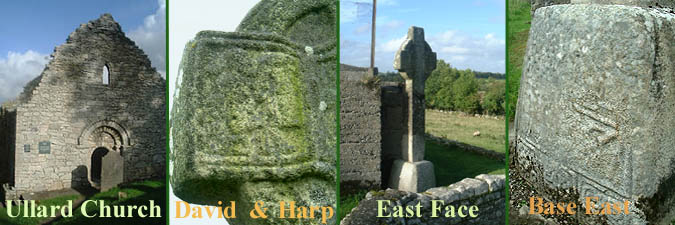The Harp
The history of the harp can be traced back via stone carvings such as the Ullard Cross in County Kilkenny, which is believed to be circa 845 AD. On the east face, left hand side of the horizontal, there is a carving believed to be David playing a harp.
Ullard Cross
In Nora Joan Clark's book 'The Story of the Irish Harp:Its History and Influence' (Clark 2003). She offers the origin of the harp as possibly starting with a U shaped lyre from South-West Asia, brought to Ireland by the Celts in their migration from Central Europe as far back as the eighth Century BC.
Clark draws this conclusion from Joan Rimmer's Book The Irish Harp [ Rimmer,1977)]. In which Rimmer states:
It seems highly probably that the characteristic stringed instrument of the Celts was a U shaped lyre, originating...in South West Asia. It seems, too, that the Celts may have preserved it in something not far removed from its original form for a thousand years or so.
Clark then continues to detail the history and use of the harp throughout Ireland's history, including its prevalence throughout the Celtic culture in Scotland, Wales, Cornwall and of course Ireland. She also introduces the Druid and Bardic traditions. Stating that;
Three distinct artistic classes were associated with the bardic tradition of druid society: the poet, the bard and the harper(p.38)
Here Clark informs us that the highest rank was the poet or file, whom composed the heroic poetry.The bard is, to all intent, a mere covers artist whose job is to simply learn and recite those poems whilst the harper afforded almost as high a status as the poet. The harper in particular, but also other musicians, were held in such high regard that they were quite often attributed as having mystical powers.
This high regard is still apparent today with the symbol of the harp adorning much of Ireland's identity, from the flag and currency down to its alcohol. In fact this regard became so apparent that Queen Elizabeth decreed in 1603 that all Irish harp players should be hung and their harps burned. This is supported by Flood (Flood 1905)
On January 28th, 1603, a proclamation was issued by the Lord President of Munster, by the terms of which the Marshal of the Province was strictly charged "to exterminate by marshal law all manner of Bards, Harpers," etc. Within ten days after said proclamation, Queen Elizabeth herself ordered Lord Barrymore "to hang the harpers wherever found, and destroy their instruments."
The following link is an excellent example of traditional harp playing performed by Paul Dooley (Irish Traditional Music Archive 2013).
Loftus Jones, harp piece - Paul Dooley, harp
In the following posts I will look at some of the other typical instruments associated with Traditional Irish Folk Music.
Reference:
Dempsey Jim,(no date). Irish High Crosses. Available at http://www.megalithicireland.com/High%20Cross%20Ullard.htm (accessed 27 September 2013).
Clark, Nora Joan. (2003) The Story of the Irish Harp:Its History and Influence. Lynwood.WA:North Creek Press. [online] Available at books.google.co.uk/books?isbn=0972420207 (accessed 27 September 2013).
Rimmer,Joan(1977) The Irish Harp Cork:The Mercier Press.
Grattan Flood, William H. (1905) A History of Irish Music. Dublin:Browne and Nolan. [online] Available at: http://www.libraryireland.com/IrishMusic/Contents.php (accessed: 27 September 2013).
Irish Traditional Music Archive (2013) Loftus Jones, harp piece / Paul Dooley, harp. Available at: http://www.itma.ie/digitallibrary/sound/loftus-jones-dooley (accessed 27 September 2013).
Loftus Jones, harp piece - Paul Dooley, harp
In the following posts I will look at some of the other typical instruments associated with Traditional Irish Folk Music.
Reference:
Dempsey Jim,(no date). Irish High Crosses. Available at http://www.megalithicireland.com/High%20Cross%20Ullard.htm (accessed 27 September 2013).
Clark, Nora Joan. (2003) The Story of the Irish Harp:Its History and Influence. Lynwood.WA:North Creek Press. [online] Available at books.google.co.uk/books?isbn=0972420207 (accessed 27 September 2013).
Rimmer,Joan(1977) The Irish Harp Cork:The Mercier Press.
Grattan Flood, William H. (1905) A History of Irish Music. Dublin:Browne and Nolan. [online] Available at: http://www.libraryireland.com/IrishMusic/Contents.php (accessed: 27 September 2013).
Irish Traditional Music Archive (2013) Loftus Jones, harp piece / Paul Dooley, harp. Available at: http://www.itma.ie/digitallibrary/sound/loftus-jones-dooley (accessed 27 September 2013).

No comments:
Post a Comment